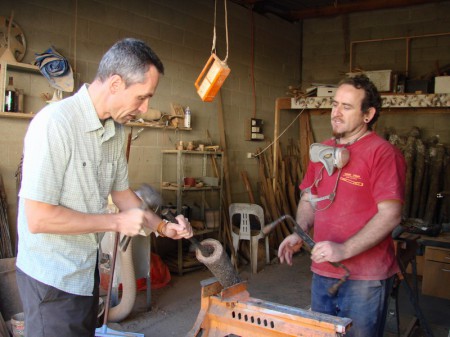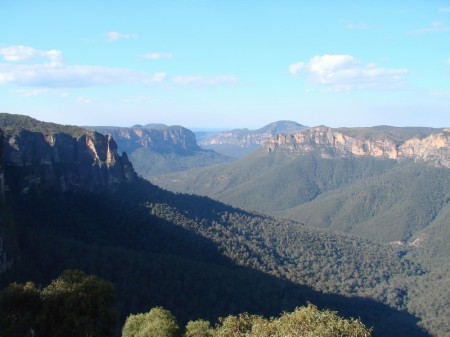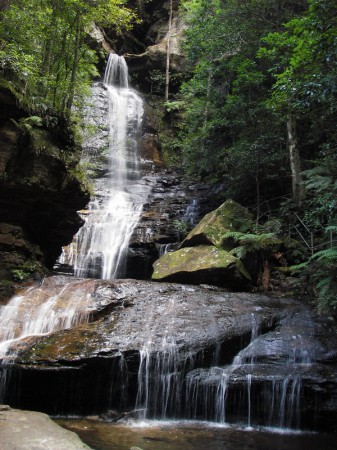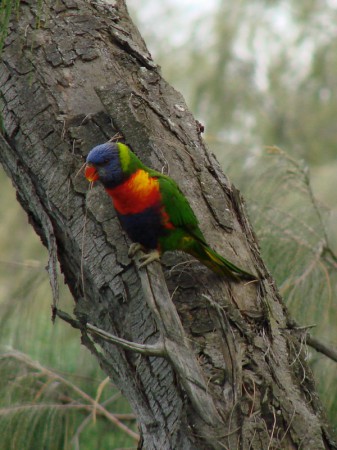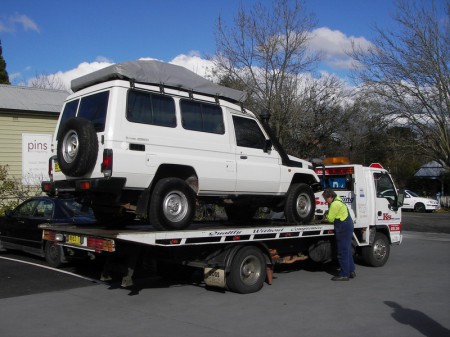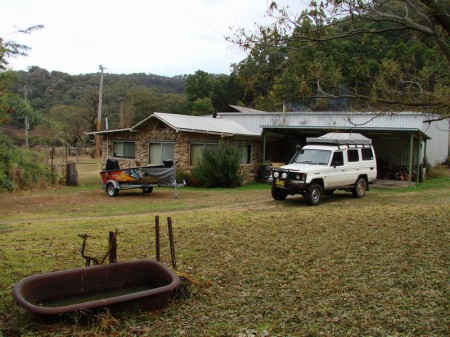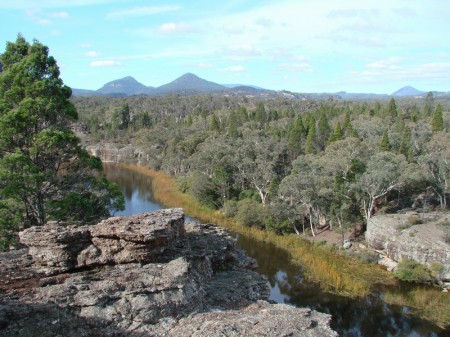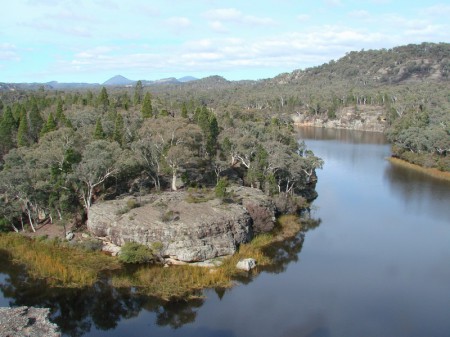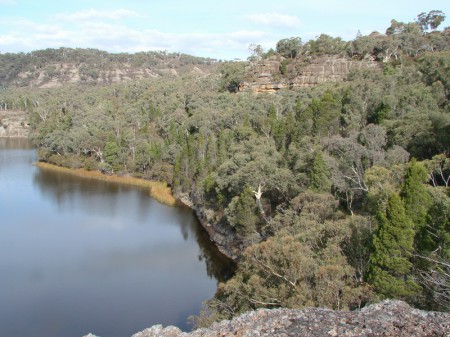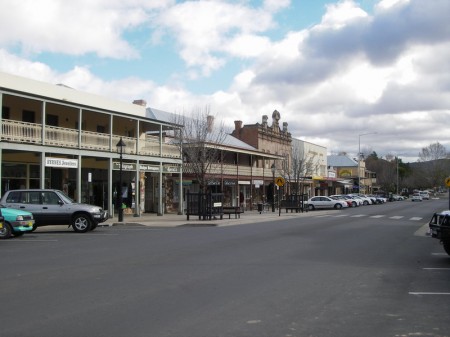Banana coast
When we left Rylstone, the sun was shining and the trip north into New England and down to Coffs Harbour on the coast was magnificent. Coming across some of the country’s large coal mines reminded us of the ongoing carbon tax debate in Australia and we wondered, what’s going to happen. Every single one of us should do whatever possible to avoid CO2 emissions, that’s for sure.
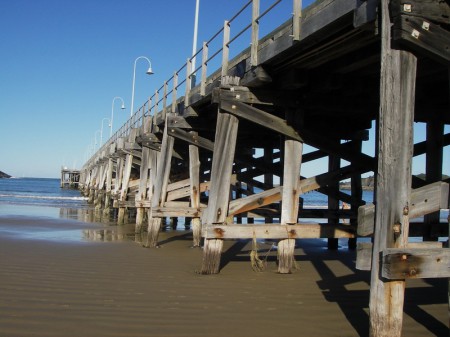 Harbour City Caravan Park in Coffs Harbour proved to be a great place to stay and we were looking forward to a couple of beautiful days in this subtropical paradise. But the bad weather seemed to follow us like a curse. When we got up the next morning, it was raining cats and dogs and it didn’t stop for days on end. Coffs and the surrounding mid north coast of NSW got up to 400mm of rain within the following 3 to 4 days and at some stage several towns got cut off by the floods, Coffs Harbour included. Eventually, after almost a week, heaven closed its gates and the waters receded.
Harbour City Caravan Park in Coffs Harbour proved to be a great place to stay and we were looking forward to a couple of beautiful days in this subtropical paradise. But the bad weather seemed to follow us like a curse. When we got up the next morning, it was raining cats and dogs and it didn’t stop for days on end. Coffs and the surrounding mid north coast of NSW got up to 400mm of rain within the following 3 to 4 days and at some stage several towns got cut off by the floods, Coffs Harbour included. Eventually, after almost a week, heaven closed its gates and the waters receded.
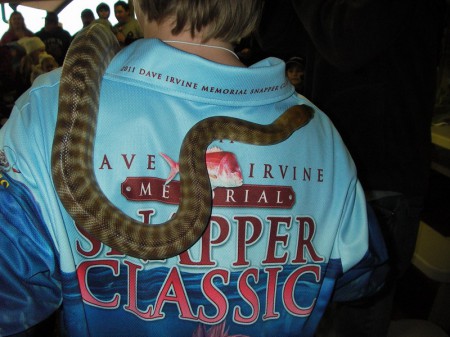 On the first weekend of our stay, a fishing competition, the Snapper Classics, took place and we went out to the Deep Sea Fishing Club to see what was going on. Sadly the horrible weather made it close to impossible for the almost 200 contestants to go out fishing on both days of the comp and in the end most of the prices had to be drawn. Almost everyone got a price though and was in a good mood and some of the best known fishermen and fishing writers in the country supported the event. Steve Starling, Kaj Bush and Scott Amon shared their knowledge with the crowd and their passion was highly contagious.
On the first weekend of our stay, a fishing competition, the Snapper Classics, took place and we went out to the Deep Sea Fishing Club to see what was going on. Sadly the horrible weather made it close to impossible for the almost 200 contestants to go out fishing on both days of the comp and in the end most of the prices had to be drawn. Almost everyone got a price though and was in a good mood and some of the best known fishermen and fishing writers in the country supported the event. Steve Starling, Kaj Bush and Scott Amon shared their knowledge with the crowd and their passion was highly contagious.
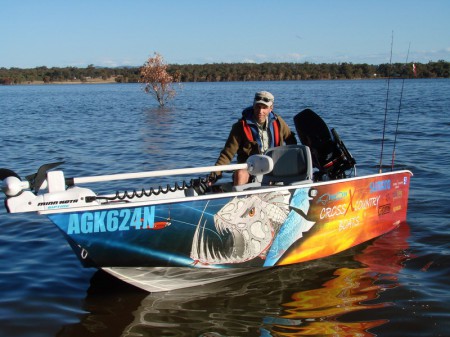 Having read and very much enjoyed some of his books and many of his profound articles in various fishing magazines, we were thrilled to meet Steve and his partner Jo. Steve and his mate, shipwright Tyson Dethridge from CrossXCountry Boats, created our great little boat and to top it all, Jo designed the stunning vinyl wrap. Jo and Starlo kindly signed our book and we greatly enjoyed the short chat with these two very friendly and welcoming people and are looking forward to keeping in contact and seeing them again sometime.
Having read and very much enjoyed some of his books and many of his profound articles in various fishing magazines, we were thrilled to meet Steve and his partner Jo. Steve and his mate, shipwright Tyson Dethridge from CrossXCountry Boats, created our great little boat and to top it all, Jo designed the stunning vinyl wrap. Jo and Starlo kindly signed our book and we greatly enjoyed the short chat with these two very friendly and welcoming people and are looking forward to keeping in contact and seeing them again sometime.
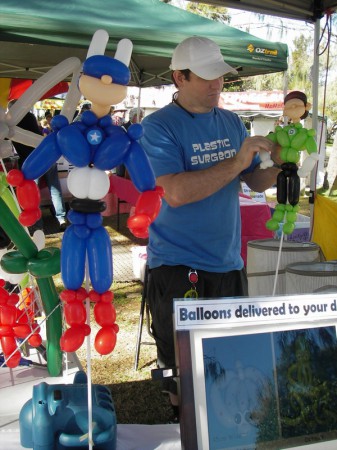 The next weekend, the weather was sunny and nice and we went down to the market near the beach. Fruit and vegetable stalls, arts and crafts people, the ice cream man and lots more made for a colorful atmosphere and everyone was enjoying the sun after all the miserable weather. One man was displaying beautiful didgeridoos and playing them with amazing skill.
The next weekend, the weather was sunny and nice and we went down to the market near the beach. Fruit and vegetable stalls, arts and crafts people, the ice cream man and lots more made for a colorful atmosphere and everyone was enjoying the sun after all the miserable weather. One man was displaying beautiful didgeridoos and playing them with amazing skill.
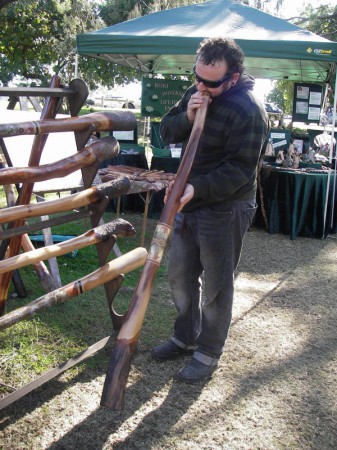 After talking to Kristian, the didge maker and player, we left with his leaflet in our pocket. In the evening we had a closer look at the leaflet and discovered that one can make one’s own instrument with Kristian’s help. www.yidakivibes.com We called him the next morning to ask how it works and decided to give it a go. The following day saw us heading to Kristian’s workshop in the morning. First we had to find the tree trunk for our instrument. There was a large amount of dried wood to choose from and Kristian answered our endless questions with great patience.
After talking to Kristian, the didge maker and player, we left with his leaflet in our pocket. In the evening we had a closer look at the leaflet and discovered that one can make one’s own instrument with Kristian’s help. www.yidakivibes.com We called him the next morning to ask how it works and decided to give it a go. The following day saw us heading to Kristian’s workshop in the morning. First we had to find the tree trunk for our instrument. There was a large amount of dried wood to choose from and Kristian answered our endless questions with great patience.
His knowledge is vast and he is putting a lot of effort into the musical quality of his instruments. He selects the trees, cuts and stores them until they are ready to become an instrument. He then spends a lot of time opening up the already hollow trunk with chisels to make sure the walls have a thickness as even as possible, all in the search for the perfect sound.
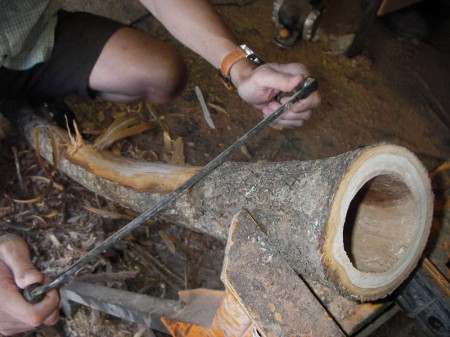
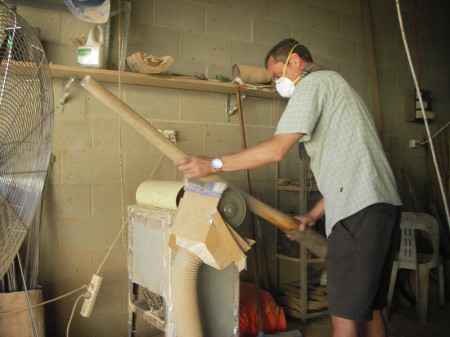 After we had chosen our piece of box wood, we had to work with the chisels as well and after several hours and quite a bit of sweat the inside of our didge started to look good. The next step was getting most of the bark off with a special knife and as a feature a bit of bark was left at the lower end of the didge. At the upper end of the instrument the thickness of the walls was then further reduced from the outside and after that we had to sand it with power tools and by hand, starting with coarse and finishing with very fine sandpaper to achieve a smooth, silky surface.
After we had chosen our piece of box wood, we had to work with the chisels as well and after several hours and quite a bit of sweat the inside of our didge started to look good. The next step was getting most of the bark off with a special knife and as a feature a bit of bark was left at the lower end of the didge. At the upper end of the instrument the thickness of the walls was then further reduced from the outside and after that we had to sand it with power tools and by hand, starting with coarse and finishing with very fine sandpaper to achieve a smooth, silky surface.
We had seen a beautiful mouthpiece made out of silky oak on one of Kristian’s instruments and with his help a piece of silky oak with an amazing grain was glued to our didgeridoo and a mouthpiece formed. To protect the instrument a first coat of varnish was applied and, 24 hours later, sanded and the second and last coat applied. When played, moisture accumulates in the instrument and may cause cracking. Kristian pours hot bees wax trough his instruments to seal them from the inside in addition to the outside varnishing. Apart from providing excellent protection, the wax smells very good indeed and makes playing the instrument even more enjoyable.
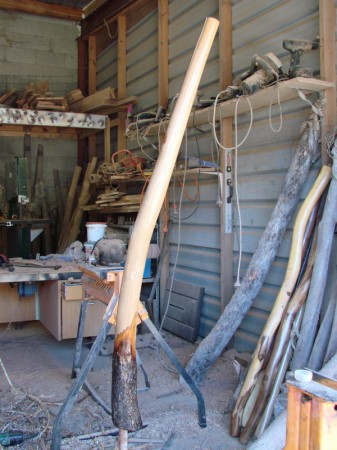 Time went by far too fast and three days after we had started we were able to pick up our finished didgeridoo. Kristian was a great tutor and we learnt heaps. To top a unique and wonderful experience, he gave us a lesson and showed us different techniques to play. Oh, and yes, our didge looks great and sounds amazing, at least when played by the master. No excuses for not practicing anymore!
Time went by far too fast and three days after we had started we were able to pick up our finished didgeridoo. Kristian was a great tutor and we learnt heaps. To top a unique and wonderful experience, he gave us a lesson and showed us different techniques to play. Oh, and yes, our didge looks great and sounds amazing, at least when played by the master. No excuses for not practicing anymore!
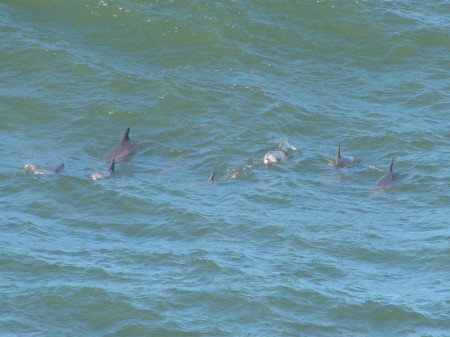 Coffs Harbour definitely has a subtropical feel to it with banana crops along the coast and a lush, rich flora. We spent many hours walking along the golden sandy beaches, watching big schools of dolphins playing in the waves. During our stay, Humpback whales started to make their appearance on their annual migration north and we saw several of these giants leaping clear out of the water or waving their huge dorsal fins in the air.
Coffs Harbour definitely has a subtropical feel to it with banana crops along the coast and a lush, rich flora. We spent many hours walking along the golden sandy beaches, watching big schools of dolphins playing in the waves. During our stay, Humpback whales started to make their appearance on their annual migration north and we saw several of these giants leaping clear out of the water or waving their huge dorsal fins in the air.
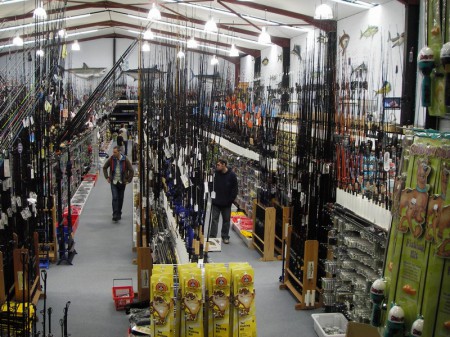 While in Coffs, we had to visit Fishing Tackle Australia, the largest tackle store we’ve ever seen by far and conveniently situated across the road from where we stayed. For a complete tackle nut, suffering from a severe case of NAD (necessary acquisition disorder; compliments to Russell Rowse in Weipa), the temptations were almost too great and we had to pull ourselves together. The range of gear is unbelievable, but the store is not only huge, the guys working there are also friendly, helpful and know their stuff. A real tackle shopper’s paradise and easily the undoing of one’s travel budget.
While in Coffs, we had to visit Fishing Tackle Australia, the largest tackle store we’ve ever seen by far and conveniently situated across the road from where we stayed. For a complete tackle nut, suffering from a severe case of NAD (necessary acquisition disorder; compliments to Russell Rowse in Weipa), the temptations were almost too great and we had to pull ourselves together. The range of gear is unbelievable, but the store is not only huge, the guys working there are also friendly, helpful and know their stuff. A real tackle shopper’s paradise and easily the undoing of one’s travel budget.
